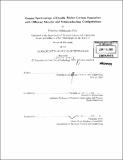| dc.contributor.advisor | Mildred S. Dresselhaus. | en_US |
| dc.contributor.author | Villalpando Páez, Federico | en_US |
| dc.contributor.other | Massachusetts Institute of Technology. Dept. of Materials Science and Engineering. | en_US |
| dc.date.accessioned | 2010-10-12T18:52:27Z | |
| dc.date.available | 2010-10-12T18:52:27Z | |
| dc.date.copyright | 2010 | en_US |
| dc.date.issued | 2010 | en_US |
| dc.identifier.uri | http://hdl.handle.net/1721.1/59238 | |
| dc.description | Thesis (Ph. D.)--Massachusetts Institute of Technology, Dept. of Materials Science and Engineering, 2010. | en_US |
| dc.description | Includes bibliographical references (p. 117-125). | en_US |
| dc.description.abstract | A double-walled carbon nanotube (DWNT) provides the simplest system to study the interaction between concentric tubes in carbon nanotubes. The inner and outer walls of a DWNT can be metallic (M) or semiconducting (S), and each of the four possible configurations (MUM, M©S, SUS, S©M) has different electronic properties. We analyze the Raman spectra from undoped and boron-doped chemical vapor deposition-derived DWNT bundles (CVD-DWNTs) that exhibit the "coalescence inducing mode" (CIM) as they are heat treated at temperatures between 12000C and 2000'C. We then report, for the first time, detailed Raman spectroscopy experiments carried out on individual DWNTs, where both concentric tubes of the same DWNT are measured under resonance conditions. A technique is developed that combines tunable Raman spectroscopy with Raman mapping procedures and electron beam lithography to enable the acquisition of Raman spectra from the individual constituents of the same isolated DWNT. By using the technique mentioned above, we measure resonant Raman scattering from 11 individual C60-derived double wall carbon nanotubes all having inner semiconducting (6,5) tubes and various outer metallic tubes. We report that in an individual DWNT an increase in the RBM frequency of the inner tube is related to an increase in the RBM frequency of the outer tube due to a decrease in the wall to wall distance. Finally, we use 40 laser excitation energies to analyze the differences in the Raman spectra from chemical vapor deposition-derived DWNT bundles (CVD-DWNTs), fullerene-derived DWNT bundles (C₆₀-DWNTs) and individual fullerene-derived DWNTs with inner type I and type II semiconducting tubes paired with outer metallic tubes. | en_US |
| dc.description.statementofresponsibility | by Federico Villalpando Páez. | en_US |
| dc.format.extent | 125 p. | en_US |
| dc.language.iso | eng | en_US |
| dc.publisher | Massachusetts Institute of Technology | en_US |
| dc.rights | M.I.T. theses are protected by
copyright. They may be viewed from this source for any purpose, but
reproduction or distribution in any format is prohibited without written
permission. See provided URL for inquiries about permission. | en_US |
| dc.rights.uri | http://dspace.mit.edu/handle/1721.1/7582 | en_US |
| dc.subject | Materials Science and Engineering. | en_US |
| dc.title | Raman spectroscopy of double walled carbon nanotubes with different metallic and semiconducting configurations | en_US |
| dc.type | Thesis | en_US |
| dc.description.degree | Ph.D. | en_US |
| dc.contributor.department | Massachusetts Institute of Technology. Department of Materials Science and Engineering | |
| dc.identifier.oclc | 666497778 | en_US |
